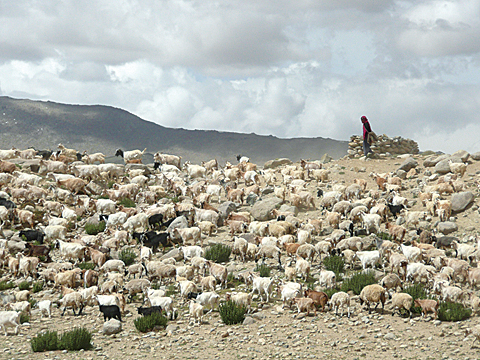Human Life, Aging and Disease in High-Altitude Environments: Physio-Medical, Ecological and Cultural Adaptation in “Highland Civilizations”
- D-03
- CR①
- CR②
2014
This project explored new perspectives regarding how people live in high-altitude environments where oxygen levels are low and natural resources are limited. We focused on aging problems and lifestyle-related diseases because we regard these as manifestations of global environmental issues in the human body. Project research also aimed to clarify the meaning of “highland civilization”, defined by human ecological, physiological, and cultural adaptations to high-altitude environments, and to describe how recent changes in lifestyle have affected quality of life (QOL) among the elderly. Based on these observations, we also proposed a model of human-nature interactions appropriate for highland civilizations. Study sites were selected from four areas in the Himalaya-Tibet region: the Ladakh region in India, the Arunachal Pradesh State in India, Khaling in Bhutan, and the Qinghai Province in China, each of which has distinct ecological and socioeconomic conditions.
Results
Human ecological and cultural adaptations in highland environments were characterized as maximal and sustainable utilization of limited but diversified natural resources, flexible management for disasters notwithstanding inherent social-ecological vulnerabilities, and a simple life with modest virtues. Human-environmental relationships were studied in three ecologically distinct zones in Himalaya-Tibet region: a forest in Arunachal Pradesh and Bhutan, the Ladakh oasis, and the grasslands of Qinghai. In Arunachal Pradesh, for example, the distribution of vegetation, ethnic groups, subsistence-related lifestyle patterns and recent change, and alien plant invasion were described from 200 to 4000 meters of altitude. Our survey of rural-to-urban migration suggested that local residents increasingly seek better education and medical service as well as the higher cash income provided by non-agricultural activities. This change in human-environment relationships, caused by various factors from local to global, uniformly resulted in the rise of lifestyle-related disease such as hypertension and diabetes. The “Himalaya model of lifestyle-related diseases” and “diabetes acceleration model” were developed to describe these trends. The background association of diabetes with high hemoglobin and oxidative stress was viewed as a trade-off with hypoxic adaptation associated with aging in highland environments.
Research communication

Nomads on Changthang plateau in Ladakh (4700 m alt).
This elderly pastoralist had recently suffered the loss of his wife, but his mental health was maintained because of his important role of looking after his livestock every day, including shifting location ten times/year, along with other pastoralists of his village. Comparative analysis with elderly of Japan indicated that the prevalence of depression in high-altitude people was relatively low in spite of severe livelihood conditions (Ishikawa 2010, 2013).
In Ladakh and Bhutan, we contributed to the design of health care systems for elderly people and described the negative effects of new lifestyle-related diseases. Grassroots international workshops involving local residents, researchers, and medical officers were conducted in Aruanchal Pradesh and Bhutan in order to discuss regionally appropriate development pathways in relation to QOL of elderly highlanders.
The project has published extensively, including: “Aging, diseases and health in the Himalayas and Tibet from medical, ecological and cultural viewpoints: studies on Arunachal Pradesh, Ladakh, and Qinghai”; “Pastoral nomadism, pastoral transhumance, and sedentary pastoralism-from the fields of Mongolia, Tibet, the Himalayas and the Andes” (in Japanese); “Himalayan Study Monographs (No. 15)” (in Japanese); “Ladakh: Ecology, Disaster, and Health”; and several chapters in a forthcoming volume on Ecohealth in the RIHN Book Series and two additional books are currently in preparation. Seminars were held every month by the project while in CR phase on the theme “The wisdom of the aged: Learning from the high-altitude elderly”; and publication of a series on field-practices are also currently in preparation (see Photo).
▲PAGE TOP